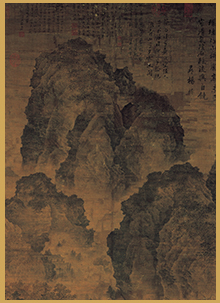
There is a large number of surviving landscape paintings in Fan Kuan’s name. Besides the most famous one, “Travelers Among Mountains and Streams,” the National Palace Museum also has “Sitting Alone by a Stream,” “Desolate Temple in Snowy Mountains,” and “Flying Cascades in Autumn Woods.” In other collections are “Snowy Scene of Wintry Trees” in the Tianjin Museum and “Winter Landscape with Temples and Travelers” in the Boston Museum of Fine Art.
Although “Sitting Alone by a Stream” is not an original by Fan Kuan, the monumentality of its centralized main peak and dense clustering of lines for trees on its mountaintops are characteristics that clearly trace back to the Fan Kuan style, as seen in “Travelers Among Mountains and Streams.” However, the brushwork of its landscape forms with chopping strokes using a slanted brushtip date the production to the time of Li Tang (ca. 1070-after 1150) from the Northern and Southern Song interval. The other works in this section, such as “Desolate Temple in Snowy Mountains,” “Fishing in Snow on a Wintry River,” “Clustered Peaks Clearing After Snow,” and “Flying Cascades in Autumn Woods,” are all later than “Sitting Alone by a Stream.” Later in the Ming and Qing dynasties, many paintings were spuriously given Fan Kuan’s name, even though they have little to do stylistically with his art.

Sitting Alone by a Stream
Fan Kuan (ca. 950-ca. 1031), Song dynasty
This painting bears neither seal nor signature of the artist, but Qing dynasty catalogue entries ascribe it to Fan Kuan.
Done on two bolts of silk, the scroll depicts mountains rising prominently in the center to create a majestic form. The peaks are filled with forests in a composition that evidently derives from Fan Kuan’s “Travelers Among Mountains and Streams.” The painting method of the rocks, however, has already departed from Fan’s “raindrop texturing” to include more slanted brushwork, to which haloes of moist ink were added in a manner similar to “small axe-cut texture strokes.” The lone figure sitting by a stream is also done with abbreviated brushwork in a style that differs from the figures in the caravan of “Travelers Among Mountains and Streams.” Accordingly, the date of production for this painting appears closer to the time of Li Tang (ca. 1070-after 1150) in the interval between the Northern and Southern Song.

Desolate Temple in Snowy Mountains
Fan Kuan (ca. 950-ca. 1031), Song dynasty
This scroll has neither seal nor signature of the artist, but the piece of paper mounted above it with a colophon by Wang Duo (1592-1652) claims it was painted by Fan Kuan.
The painting depicts various peaks reaching up to the heavens and covered in thick forests. Connected by ridges with dense trees, the scenery is also dotted with an old temple, frontier pass, cold spring, and travelers. The force of the mountains is quite solid and powerful, the arrangement orderly yet somewhat varied as well. Washes of ink suggest a hazy sky, which highlights an atmosphere of snowy peaks and deep cold. Compared to “Travelers Among Mountains and Streams,” the method of texturing the landscape and painting the trees has already become more abstracted, suggesting a later date of production. Nonetheless, this work is still a valuable reference for understanding Fan Kuan’s style.




